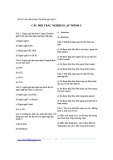
Writing do Statements
The while and for statements both test their Boolean expression at the start of the loop.
This means that if the expression evaluates to false on the very first test, the body of the
loop does not run, not even once. The do statement is different; its Boolean expression is
evaluated after each iteration, and so the body always executes at least once.
The syntax of the do statement is as follows (don't forget the final semicolon):
do
statement
while (booleanExpression);
Use a statement block if the body of the loop comprises more than one statement. Here's
a version of the previous example that writes the values 0 through 9 to the console, this
time using a do statement:
int i = 0;
do
{
Console.WriteLine(i);
i++;
}
while (i != 10);
The break and continue Statements
In Chapter 4, you saw the break statement being used to jump out of a switch statement.
You can also use a break statement to jump out of the body of an iteration statement.
When you break out of a loop, the loop exits immediately and execution continues at the
first statement after the loop. Neither the update nor the continuation condition of the
loop is re-run.
In contrast, the continue statement causes the program to immediately perform the next
iteration of the loop (after re-evaluating the Boolean expression). Here's a version of the
previous example that writes the values 0 through 9 to the console, this time using break
and continue statements:
int i = 0;
while (true)
{
Console.WriteLine("continue " + i);
i++;

if (i != 10)
continue;
else
break;
}
This code is absolutely ghastly. Many programming guidelines recommend using
continue cautiously or not at all because it is often associated with hard-to-understand
code. The behavior of continue is also quite subtle. For example, if you execute a
continue statement from inside a for statement, the update part runs before performing the
next iteration of the loop.
In the following exercise, you will write a do statement to convert a number to its string
representation.
Write a do statement
1. Using Visual Studio 2005, open the DoStatement project, located in the \Microsoft
Press\Visual CSharp Step by Step\Chapter 5\DoStatement folder in your My
Documents folder.
2. On the Debug menu, click Start Without Debugging.
Visual Studio 2005 builds and runs the Windows application.
The application displays a form that has two text boxes and the Show Steps
button. When you type a positive number (the algorithm used doesn't work with
negative numbers) in the upper text box, and click the Show Steps button, the
lower text box shows the steps used to create a string representation of this
number.
NOTE
This is simply an example showing you how to convert a number to a string using
a do loop. The .NET Framework provides the Convert.ToString method which
does the same thing, and is the method you should really use to perform this task if
you need it in your own applications.
3. As an example, type 2693 in the upper text box, and then click Show Steps.
The lower text box displays the steps used to create a string representation of
2693:

4. Close the window to return to the Visual Studio 2005 programming environment.
5. Display the code for Form1.cs in the Code and Text Editor window.
6. Locate the showSteps_Click method. This method runs when the user clicks the
Show Steps button on the form.
This method contains the following statements:
int amount = System.Int32.Parse(number.Text);
steps.Text = "";
string current = "";
do
{
int digitCode = '0' + amount % 10;
char digit = Convert.ToChar(digitCode);
current = digit + current;
steps.Text += current + "\r\n";
amount /= 10;
}
while (amount != 0);
NOTE
\r indicates a carriage return. When writing text to a multiline TextBox control,
you need to output a carriage return and a newline to proceed to the next line and
return the cursor to the start of the line. Without it, the text will all appear on the
same line.
The first statement converts the string value in the Text property of the number
text box into an int using the Parse method of the System.Int32 class:
int amount = System.Int32.Parse(number.Text);
The second statement clears the text displayed in the lower text box (called steps)
by setting its Text property to the empty string:
steps.Text = "";
The third statement declares a string variable called current and initializes it to the
empty string:
string current = "";
The real work in this method is performed by the do statement which begins at the
fourth statement:

do
{
...
}
while (amount != 0);
The algorithm repeatedly uses integer arithmetic and the modulus operator to
divide the amount variable by 10; the remainder after each successive division
constitutes the next digit in the string being built. Eventually amount is reduced to
zero, and the loop finishes. Notice that the body must run at least once. This
behavior is exactly what is required because even the number 0 has one digit.
The first statement inside the do loop is:
int digitCode = '0' + amount % 10;
This statement declares an int variable called digitCode and initializes it to the
result of the following expression:
'0' + amount % 10
This expression requires a little explanation! The value of '0'is the zero character.
In the character set used by Windows, this character equates to the integer value
48 (each character has its own unique character code which is an integer value).
Similarly, the character code for '1' is 49, the character code for '2' is 50, and so
on.
The value of amount % 10 is the remainder you get when you divide amount by
10. For example, if amount contains the value 2693, then 2693 % 10 is 3. (2693
divided by 10 is 269 with a remainder of 3.) Therefore, if amount equals 2693,
then the expression '0' + amount % 10 is the same as '0' + 3, which is 51. This is
the code for the character '3'. (The + operator performs an implicit cast, converting
'0' to the integer value 48 to allow this expression to be evaluated.)
The second statement inside the do loop is:
char digit = Convert.ToChar(digitCode);
This statement declares a char variable called digit and initializes it to the result of
the Convert.ToChar(digitCode) method call. This method call returns the char
with the integer character code value of the argument. In other words, the value of
Convert.ToChar('0' + 3) is the value of ‘3'.
The third statement inside the do loop is:

current = digit + current;
This statement prepends the char digit just calculated to the current string. Notice
that this statement cannot be replaced by current += digit, because that would
append the digit.
The fourth statement inside the do loop is:
steps.Text += current + "\r\n";
This statement appends another step to the Text property of the Steps text box.
The final statement inside the do loop is:
amount /= 10;
This statement is the same as amount = amount / 10;. If the value of amount is
2693, the value of amount after this statement runs is 269. Notice that each
iteration through the do statement removes the last digit from amount and
prepends that digit to the current string.
In the final exercise, you will use the Visual Studio 2005 debugger to step through the
previous do statement to help you understand how it works.
Step through the do statement
1. In the Code and Text Editor window, find the showSteps_Click method.
2. Move the cursor to the first statement of the showSteps_Click method.
The first statement is as follows:
int amount = System.Int32.Parse(number.Text);
3. Right-click anywhere in the first statement and click Run To Cursor.
Visual Studio 2005 builds and runs the application.
4. When the form appears, type 2693 in the upper text box, and then click Show
Steps.
The program stops and you are placed in Visual Studio 2005 in debug mode. A
yellow arrow in the left margin of the Code and Text Editor window indicates the
current statement.











![Tài liệu ôn tập môn Lập trình web 1 [mới nhất/chuẩn nhất]](https://cdn.tailieu.vn/images/document/thumbnail/2025/20251208/hongqua8@gmail.com/135x160/8251765185573.jpg)









![Hệ thống quản lý cửa hàng bán thức ăn nhanh: Bài tập lớn [chuẩn nhất]](https://cdn.tailieu.vn/images/document/thumbnail/2025/20251112/nguyenhuan6724@gmail.com/135x160/54361762936114.jpg)
![Bộ câu hỏi trắc nghiệm Nhập môn Công nghệ phần mềm [mới nhất]](https://cdn.tailieu.vn/images/document/thumbnail/2025/20251111/nguyenhoangkhang07207@gmail.com/135x160/20831762916734.jpg)



